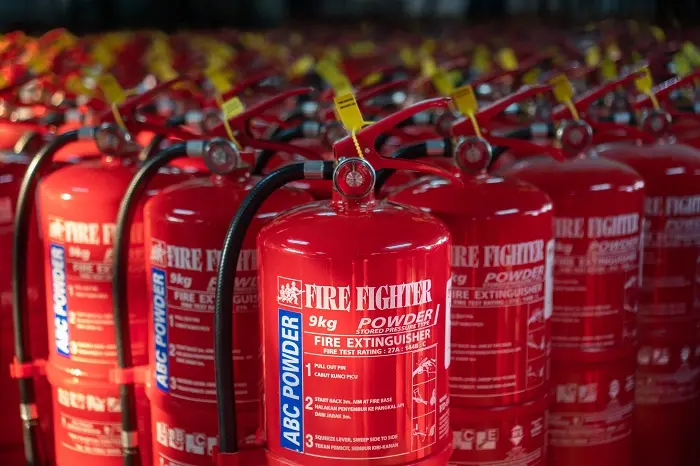Flammable liquids pose a significant fire hazard in various settings, including homes, workplaces, and industrial environments. Understanding the types of fire extinguishers designed to combat flammable liquid fires is essential for effective fire safety and prevention. This comprehensive guide explores the nature of flammable liquid fires, the classifications of fire extinguishers, and best practices for selecting and using the appropriate extinguisher.
Understanding Flammable Liquids
What Are Flammable Liquids?
Flammable liquids are substances that can easily ignite and cause fires. They have low flash points, meaning they can produce enough vapor to form an ignitable mixture with air at relatively low temperatures. Common examples include gasoline, alcohol, paint thinners, and solvents.
The Dangers of Flammable Liquids Fires
Fires involving flammable liquids can spread rapidly and are often more challenging to control than other types of fires. The volatility of these liquids can lead to explosive reactions, making it crucial to have the right firefighting equipment on hand.
Classifying Fires
Understanding Fire Classes
Fires are classified into different categories based on the materials that fuel them. The classification helps in determining the appropriate firefighting methods and equipment. The key classes relevant to flammable liquids include:
Class B Fires: These fires involve flammable liquids, gases, and greases. They are commonly found in kitchens, garages, and industrial settings.
Class A Fires: Involve ordinary combustibles like wood, paper, and cloth.
Class C Fires: Involve energized electrical equipment.
Importance of Correct Classification
Using the wrong type of extinguisher can exacerbate the fire or create hazardous situations. Therefore, knowing the classification of the fire is critical for effective firefighting.
Types of Fire Extinguishers for Flammable Liquids
1. Class B Fire Extinguishers
Class B extinguishers are specifically designed to combat fires involving flammable liquids. They contain agents that can smother the fire and interrupt the combustion process.
Common Agents Used in Class B Extinguishers
Foam: Aqueous film-forming foam (AFFF) creates a barrier that suffocates the fire by cutting off its oxygen supply.
Dry Chemical: Multi-purpose dry chemical extinguishers (ABC) contain agents like ammonium sulfate, which disrupts the chemical reaction of the fire.
Carbon Dioxide (CO2): CO2 extinguishers displace oxygen and are effective for flammable liquid fires, especially in confined spaces.
2. Water Mist Extinguishers
Water mist extinguishers can be effective for certain flammable liquid fires by cooling the fire and reducing vapor production. However, they are not suitable for all flammable liquids and should be used with caution.
3. Specialty Extinguishers
Some fires involving flammable liquids may require specialty extinguishers, such as those designed for specific industrial applications. Always consult local fire codes and guidelines for the best practices in your area.
Selecting the Right Extinguisher
Factors to Consider
When selecting an extinguisher for flammable liquid fires, consider the following factors:
Type of Flammable Liquid: Different flammable liquids may require different types of extinguishers.
Location of Use: Consider whether the extinguisher will be used in a home, office, or industrial setting.
Size and Weight: Ensure the extinguisher is easy to handle and store in case of an emergency.
Accessibility: Place extinguishers in easily accessible locations, especially near areas prone to flammable liquid use.
Fire Safety Standards
Always comply with local fire safety codes and regulations when selecting and installing fire extinguishers. Ensure that extinguishers are regularly inspected and maintained.
Best Practices for Using Fire Extinguishers
Steps to Follow
Assess the Situation: Ensure you can safely approach the fire. If it’s too large or spreading quickly, evacuate and call emergency services.
Use the P.A.S.S. Method:
Pull the pin.
Aim low at the base of the fire.
Squeeze the handle to discharge.
Sweep side to side until the fire is out.
Monitor the Area: After extinguishing the fire, watch for re-ignition. If the fire reignites, use the extinguisher again and evacuate if necessary.
Preventing Flammable Liquid Fires
Safety Tips
Proper Storage: Store flammable liquids in approved containers and away from heat sources.
Ventilation: Ensure proper ventilation when using flammable liquids to disperse vapors.
Regular Inspections: Regularly inspect equipment and storage areas for leaks or hazards.
Training: Provide training for employees or family members on fire safety and the proper use of extinguishers.
Conclusion
Understanding the nature of flammable liquid fires and the appropriate extinguishers is essential for safety. By selecting the right extinguisher and implementing best practices for prevention and response, you can significantly reduce the risks associated with these hazardous materials. Always prioritize safety and compliance with local fire codes to ensure a safe environment for all.
Related topics:

